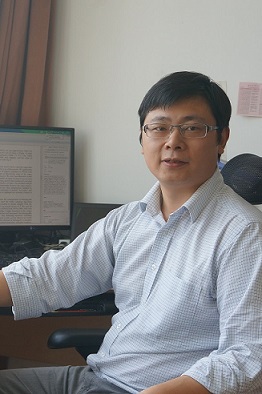Lecturer: Tie-Yan LIU, Microsoft Research Asia
Short Bio:  Tie-Yan Liu is an assistant managing director of Microsoft Research Asia, leading the machine learning research area. He is very well known for his pioneer work on learning to rank and computational advertising, and his recent research interests include deep learning, reinforcement learning, and distributed machine learning. He is an adjunct/honorary professor at Carnegie Mellon University (CMU), University of Nottingham, and several other universities in China. He has published 200+ papers in refereed conferences and journals, with over 17000 citations. He has won quite a few awards, including the best student paper award at SIGIR (2008), the most cited paper award at Journal of Visual Communications and Image Representation (2004-2006), the research break-through award (2012) and research-team-of-the-year award (2017) at Microsoft Research, and Top-10 Springer Computer Science books by Chinese authors (2015), and the most cited Chinese researcher by Elsevier (2017). He has been invited to serve as general chair, program committee chair, local chair, or area chair for a dozen of top conferences including SIGIR, WWW, KDD, ICML, NIPS, IJCAI, AAAI, ACL, ICTIR, as well as associate editor of ACM Transactions on Information Systems, ACM Transactions on the Web, and Neurocomputing. Tie-Yan Liu is a fellow of the IEEE, and a distinguished member of the ACM.
Tie-Yan Liu is an assistant managing director of Microsoft Research Asia, leading the machine learning research area. He is very well known for his pioneer work on learning to rank and computational advertising, and his recent research interests include deep learning, reinforcement learning, and distributed machine learning. He is an adjunct/honorary professor at Carnegie Mellon University (CMU), University of Nottingham, and several other universities in China. He has published 200+ papers in refereed conferences and journals, with over 17000 citations. He has won quite a few awards, including the best student paper award at SIGIR (2008), the most cited paper award at Journal of Visual Communications and Image Representation (2004-2006), the research break-through award (2012) and research-team-of-the-year award (2017) at Microsoft Research, and Top-10 Springer Computer Science books by Chinese authors (2015), and the most cited Chinese researcher by Elsevier (2017). He has been invited to serve as general chair, program committee chair, local chair, or area chair for a dozen of top conferences including SIGIR, WWW, KDD, ICML, NIPS, IJCAI, AAAI, ACL, ICTIR, as well as associate editor of ACM Transactions on Information Systems, ACM Transactions on the Web, and Neurocomputing. Tie-Yan Liu is a fellow of the IEEE, and a distinguished member of the ACM.
Abstract: Neural machine translation (NMT) has achieved remarkable success in recent years. In this tutorial, I will first introduce the basic concepts and current development of NMT. Then I will point out some technical challenges in both the learning and inference procedures of NMT and discuss how we can tackle these challenges by research innovations. In particular, I will talk about dual learning, a new learning paradigm than can leverage the symmetric structure of machine translation to effectively learn from monolingual data. Then, I will introduce several other technologies, including an MCTS-based decoding method which can avoid the myopic inference caused by standard beam search, and a new network architecture called deliberation nets which can achieve better translation results by using multi-round refinement in the decoding process. With the help of these new technologies, we have achieved human parity in Chinese-to-English news translation. At the end of the talk, I will mention a few other important directions to explore regarding NMT.
Lecturer: Xipeng Qiu, Fudan University
Short Bio:  Xipeng Qiu is an associate professor and Ph.D. supervisor at the School of Computer Science, Fudan University. He received B.S. and Ph.D. degrees from Fudan University. His major research areas include artificial intelligence, machine learning, deep learning, and natural language processing. He has published more than 50 papers in the top journals and conferences (ACL/EMNLP/IJCAI/AAAI, etc.). He is lead developer of the open source project FudanNLP for Chinese language processing. He was selected for the Young Elite Scientists Sponsorship Program by China Association for Science and Technology (CAST) and won the Outstanding Paper Award of ACL 2017.
Xipeng Qiu is an associate professor and Ph.D. supervisor at the School of Computer Science, Fudan University. He received B.S. and Ph.D. degrees from Fudan University. His major research areas include artificial intelligence, machine learning, deep learning, and natural language processing. He has published more than 50 papers in the top journals and conferences (ACL/EMNLP/IJCAI/AAAI, etc.). He is lead developer of the open source project FudanNLP for Chinese language processing. He was selected for the Young Elite Scientists Sponsorship Program by China Association for Science and Technology (CAST) and won the Outstanding Paper Award of ACL 2017.
Abstract: In the past few years, deep learning has made great progress in natural language processing (NLP), but the extent of progress is not as significant as it is in computer vision. One of the important reasons is the data insufficiency problem. Because the annotation cost of NLP tasks is quite high, the available datasets is usually not very large for many NLP tasks, which limits the abilities of the deep models. However, different NLP tasks usually have some certain correlations. For example, the tasks of part-of-speech tagging and syntactic analysis can be promoted each other. In this way, a method that can effectively solve the problem of data scarcity for NLP is multi-task learning. Multi-task learning is to learn multiple tasks together and fully exploit the correlation between multiple tasks to improve the accuracy of each single task, thereby reducing the need for training data for each task. At present, multi-task learning has achieved very good results in many NLP tasks. This report mainly introduces the multi-task learning methods in natural language processing, including different sharing schemes (hard sharing, soft sharing, and parallel sharing) and some specific multi-task learning models from the perspectives of multi-domain, multi-level, multi- language and multi-modality.
Lecturer: Jian-Yun Nie, University of Montreal
Short Bio:  Jian-Yun Nie is a professor in University of Montreal. He has been working in the areas of information retrieval and natural language processing for more than 30 years. His research spans a wide range of IR topics, including information retrieval models, cross-language information retrieval, query expansion and understanding, utilization of query logs, and so on. Jian-Yun Nie has published a number of papers in IR and NLP. He is on editorial board of 6 international journals, and regularly serves as PC member of the major conferences in these areas. Among other services, he has served as a general chair of SIGIR 2011, and will serve as a PC member of SIGIR 2019.
Jian-Yun Nie is a professor in University of Montreal. He has been working in the areas of information retrieval and natural language processing for more than 30 years. His research spans a wide range of IR topics, including information retrieval models, cross-language information retrieval, query expansion and understanding, utilization of query logs, and so on. Jian-Yun Nie has published a number of papers in IR and NLP. He is on editorial board of 6 international journals, and regularly serves as PC member of the major conferences in these areas. Among other services, he has served as a general chair of SIGIR 2011, and will serve as a PC member of SIGIR 2019.
Abstract: The great successes of deep learning techniques in image and speech processing have triggered tremendous interests for neural IR. Two main families of approaches have been proposed: representation-based and interaction-based models. The former aims at creating appropriate representations of documents and queries, while the latter try to learn the matching patterns between them. Experimental results suggest that interaction-based models have an edge on representation-based models. In this tutorial, we will review the main approaches in the two categories. Analyses will be provided to understand the success or failure of them. Some future research avenues to neural IR will be discussed.
Lecturer: Yue Zhang, Westlake University
Short Bio:  Yue Zhang is currently an associate professor at WestLake University. Before joining WestLake University, he worked as an assistant professor in SUTD. Before joining SUTD in July 2012, he worked as a postdoctoral research associate in University of Cambridge, UK. Yue Zhang received his DPhil and MSc degrees from University of Oxford, UK, and his BEng degree from Tsinghua University, China. His research interests include natural language processing, machine learning and artificial Intelligence. He has been working on statistical parsing, parsing, text synthesis, machine translation, sentiment analysis and stock market analysis intensively. Yue Zhang serves as the reviewer for top journals such as Computational Linguistics, Transaction of Association of Computational Linguistics (standing review committee) and Journal of Artificial Intelligence Research. He is the associate editor for IEEE Transaction on Big Data and ACM Transactions on Asian and Low Resource Language Information Processing. He is also PC member for conferences such as ACL, COLING, EMNLP, NAACL, EACL, AAAI and IJCAI. He was the area chairs of COLING 2014/18, NAACL 2015, EMNLP 2015/17, ACL 2017/18. He is the TPC chair of IALP 2017.
Yue Zhang is currently an associate professor at WestLake University. Before joining WestLake University, he worked as an assistant professor in SUTD. Before joining SUTD in July 2012, he worked as a postdoctoral research associate in University of Cambridge, UK. Yue Zhang received his DPhil and MSc degrees from University of Oxford, UK, and his BEng degree from Tsinghua University, China. His research interests include natural language processing, machine learning and artificial Intelligence. He has been working on statistical parsing, parsing, text synthesis, machine translation, sentiment analysis and stock market analysis intensively. Yue Zhang serves as the reviewer for top journals such as Computational Linguistics, Transaction of Association of Computational Linguistics (standing review committee) and Journal of Artificial Intelligence Research. He is the associate editor for IEEE Transaction on Big Data and ACM Transactions on Asian and Low Resource Language Information Processing. He is also PC member for conferences such as ACL, COLING, EMNLP, NAACL, EACL, AAAI and IJCAI. He was the area chairs of COLING 2014/18, NAACL 2015, EMNLP 2015/17, ACL 2017/18. He is the TPC chair of IALP 2017.
Abstract: Joint models solve multiple tasks simultaneously. They have been widely used in NLP, including joint word segmentation and POS tagging, joint named entity recognition and sentiment classification, joint syntactic and semantic parsing, etc. Compared with separate models, joint models have two main advantages. First, they allow interaction between different tasks, thereby improving accuracies by information sharing. Second, compared with traditional pipeline methods, they reduce error propagation from one task to another. Joint models include graph-based methods, transition-based methods, statistical methods, neural methods, methods that do joint training, separate decoding, joint decoding, spears training, or joint training, joint decoding. This talk introduces existing joint models, summarising them into the categories above. We also talk about adversarial training, which is a technique used in neural joint models to remove domain differences.
Lecturer: Yiqun Liu, Tsinghua University
Short Bio:  Yiqun Liu is a tenured associated professor at Tsinghua University. He served as a board member at Chinese Association for Artificial Intelligence, Chinese Information Processing Society of China, as well as an associate director of the specialized group on information retrieval and content security. His research interests are information retrieval and web search. He was invited to be the co-editor of FnTIR, PC chair of NCTIR 2013, SIGIR 2017 short paper track and SIGIR 2018 full paper track. He was awarded the first prize of 2015 Beijing Science and Technology and first prize of 2010 Chinese Information Processing Science and Technology. He was funded by 2016 NSFC Excellent Young Scholars and 2017 NSFC Key Program.
Yiqun Liu is a tenured associated professor at Tsinghua University. He served as a board member at Chinese Association for Artificial Intelligence, Chinese Information Processing Society of China, as well as an associate director of the specialized group on information retrieval and content security. His research interests are information retrieval and web search. He was invited to be the co-editor of FnTIR, PC chair of NCTIR 2013, SIGIR 2017 short paper track and SIGIR 2018 full paper track. He was awarded the first prize of 2015 Beijing Science and Technology and first prize of 2010 Chinese Information Processing Science and Technology. He was funded by 2016 NSFC Excellent Young Scholars and 2017 NSFC Key Program.
Abstract: When users interact with Web search engines, they leave rich implicit feedback information in the form of submitting queries, query reformulations, result clicks, cursor movements etc. These user behavior signals contain valuable information about how users seek information in Web search scenarios and therefore are extremely important for the understanding of the information perceiving process of human and performance improvement of search engine systems. In this lecture, I will start by talking about the behavior patterns of users in querying, examining and clicking results during both desktop and mobile search processes. Based on these existing findings in user search behavior, we will go through some popular behavior models which bring us from single user to user crowds, from homogeneous to heterogeneous result environments and from single-query to multiple-query sessions. After that, we will use some examples to show how these models help search engines to improve the performance of result ranking, user intent understanding and user interface/evaluation metric designing.
Lecturer: Jie Bao, Memect
Short Bio:  Dr. Bao is the Co-founder and CEO at Memect. Employing Knowledge Graph, Memect is committed to understanding financial document and financial knowledge modelling to support financial institutions. Dr. Bao has authored more than 70 research papers in journals, peer-reviewed international conferences and workshops. His publications cover a broad range of topics including semantic data integration, knowledge discovery, modular ontologies, distributed reasoning, privacy and trust, and semantic wikis. He is a member of Language and Knowledge Computing Committee of Chinese Information Processing Society since 2015, Advisory Committee Member of W3C and the Chairman of CCKS Industrial Forum in 2016, co-initiating Open Knowledge Graph(OpenKG) since 2017. While he was a member of the OWL Working Group of W3C, he co-authored several important OWL 2 standardization documents.
Dr. Bao is the Co-founder and CEO at Memect. Employing Knowledge Graph, Memect is committed to understanding financial document and financial knowledge modelling to support financial institutions. Dr. Bao has authored more than 70 research papers in journals, peer-reviewed international conferences and workshops. His publications cover a broad range of topics including semantic data integration, knowledge discovery, modular ontologies, distributed reasoning, privacy and trust, and semantic wikis. He is a member of Language and Knowledge Computing Committee of Chinese Information Processing Society since 2015, Advisory Committee Member of W3C and the Chairman of CCKS Industrial Forum in 2016, co-initiating Open Knowledge Graph(OpenKG) since 2017. While he was a member of the OWL Working Group of W3C, he co-authored several important OWL 2 standardization documents.
Abstract: Knowledge graph is partially originated from the semantic web technology developed in the past two decades. However, the “semantic” part is often neglected in applications, thus a knowledge graph is used solely as data to query without utilization of its knowledge inference. This may be because the classical definition of “semantics” encounters real-word difficulties in engineering, such as high cost and vulnerability to dirty data. This tutorial summarizes some best practices in applying semantics in engineering. It has three parts: 1) a brief review of the model theoretical semantics of classical semantic web, including the semantics of RDF and OWL; 2) typical difficulties of applying the classical semantics; 3) some best practices in applications, including inference closure, word vectors, using query to replace reasoning, maintainable rules and hybrid reasoning.

































